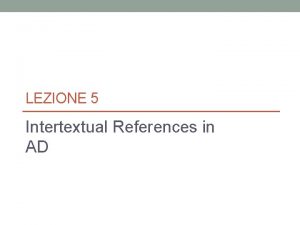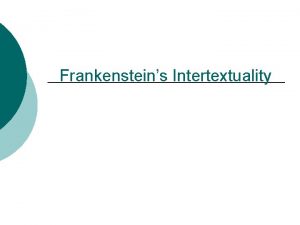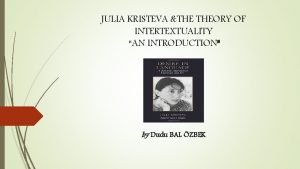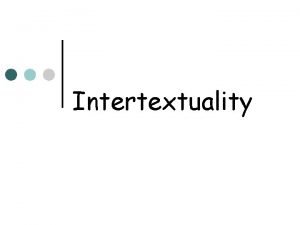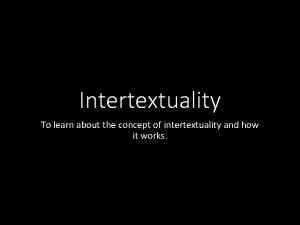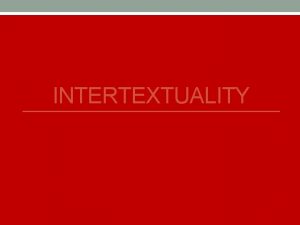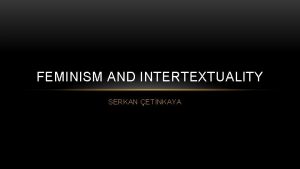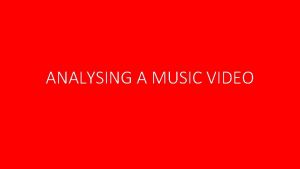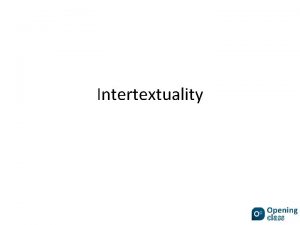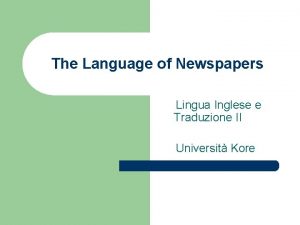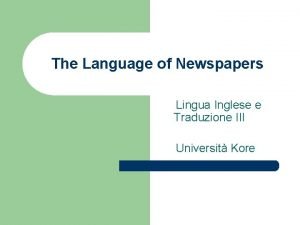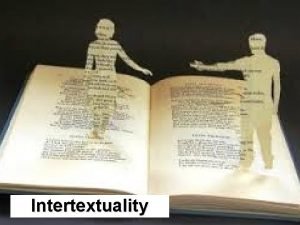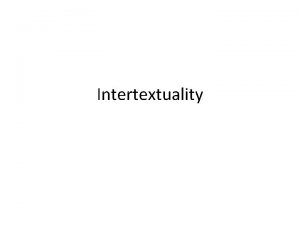Text Context and Intertextuality text instance of a

















- Slides: 17

Text, Context and Intertextuality

text instance of a verbal record context everything around the text intertextuality text's relation with other texts

1. Text as any record of a verbal message 2. Text as any instance of the organisation of human signs both context and intertextuality have the core 'text' from Latin verb texere, weave noun textus, 'tissue'

Context, Latin with-text physical and cultural conditions in which a text comes into being four kinds: context meaning immediate situation: whenever and wherever you are reading this book context meaning larger cultural frame of reference the society, language community, historical moment in which the reading takes place contexts of (re)production: when, where and by whom this book was sketched, drafted, read, redrafted, edited, published contexts of reception: who uses it when, where, how and why

co-text, other words and images in the immediate vicinity of a text. One paragraph a text, rest of page the co-text must take all four into account to grasp a text in some way see a text not only in but as its contexts

intertextuality -- between-texts - relation between one text and another three kinds: explicit intertextuality: overtly referred to. T. S. Eliot's The Waste Land notes referring to The Golden Bough, Wagner etc. implied intertextuality passing allusions to other texts, ironic, satiric to be picked up by alert reader Chaucer: Aprille with his shoures soote (sweet) First line of The Waste Land: April is the cruelest month Orwell: It was a bright cold day in April, and the clocks were striking thirteen. inferred intertextuality: texts that readers draw on to understand the text in hand not in the writer's mind, or existed at the time compare The Waste Land to cubist art po-mo, tv adverts, pop vidoes process of weaving, rather than finished web

Julia Kristeva intertextuality is ‘a mosaic of quotations; any text is the absorption and transformation of another. The notion of intertextuality replaces that of intersubjectivity, and poetic language is read as at least double. ’

Mary Orr ‘Intertextuality’, then, was the linguistic Big Bang, the deconstruction of ‘Text’ into texts and intertexts where these two terms ultimately become synonymous.

Mikhail Bakhtin “The dialogic nature of consciousness, the dialogic nature of human life itself. The single adequate form for verbally expressing authentic human existence is the open-ended dialogue. Life by its very nature is dialogic. To live means to participate in dialogue: to ask questions, to heed, to respond, to agree, and so forth. In this dialogue a person participates wholly and throughout his whole life: with his eyes, lips, hands, soul, spirit, with his whole body and deeds. He invests his entire self in discourse, and this discourse enters into the dialogic fabric of human life, into the world symposium”

Bakhtin “A plurality of independent and unmerged voices and consciousnesses, a genuine polyphony of fully valid voices is in fact the chief characteristic of Dostoevsky’s novels. What unfolds in his novels is not a multitude of characters and fates in a single objective world, illuminated by a single authorial consciousness; rather a plurality of consciousnesses, with equal rights and each with his own world, combine but are not merged in the unity of the event[s he depicts]”

Roland Barthes The text is a productivity. Not in the sense that it is a product of being worked (as narrative technique or the mastery of style would demand), but as the very theatre of a production where the producer of the text and the reader come together: the text ‘works’ whenever and however it is taken up; even in written fixed form, the text does not stop working, or undertaking a process of production. The text deconstructs the language of communication, representation or expression [. . . ] and reconstructs another language. [. . . ] Every text is an intertext; other texts are present within it to varying degrees and in more or less recognisable forms. [. . . ] Every text is a new tissue of recycled citations. Fragments of codes, formulae, model rhythms, bits of social discourse pass into the text and are redistributed within it. [. . . ] The intertext is a field of anonymous formulae whose origin is rarely recoverable, of unconscious or automatic citations without speech marks.

Kristeva The word as minimal textual unit thus turns out to occupy the status of mediator, linking structural models of cultural (historical) environment, as well as that of regulator, controlling mutations from diachrony to synchrony, i. e. , to literary structure. The word is spatialized: through the very notion of status, it functions in three dimensions (subject-addressee-context) as a set of dialogical, semic elements or as a set of ambivalent elements. Consequently the task of literary semiotics is to discover other formalisms corresponding to different modalities of word-joining (sequences) within the dialogical space of texts.

Mary Orr on Riffaterre The main difference is that Riffaterre focuses on the ‘perceiver’ and language code-breaker (the reader), not on the accretive text. Almost more important, Riffaterre develops a theory of reading that foregrounds the various kinds of textual logic and binary matrices we discovered above in Kristeva’s theory of intertextuality as productivity and permutation.

Orr Angenot highlighted the positively oppositional forces of multiplicity, heterogeneity and exteriority that Kristeva’s version of intertextuality demonstrates…. If interdiscursivity challenges intertextuality precisely where text replaced intersubjectivity, and can unpack historico-cultural particulars where intertextuality’s synchronicity is unable to do this, it cannot, however, provide the same meta-level of interrogation as Kristevan or postmodern intertextuality, which easily accommodates ‘ordinary’ and ‘poetic’ language as ‘text’.

Orr on Interdiciplinarity Interdisciplinarity, on the other hand, has never displaced its humanistic core, only rethought it in the light of the shifting boundaries of individual human disciplines. While interdisciplinarity’s bias has been towards the same scientific paradigms that largely determined the disciplines that preceded it, its concerns are less withorders of things than with second-order modes of knowledge, that is the re-examination of how such frames of reference are drawn up in the first place.

Orr on Hypertextuality Like postmodern intertextuality, electronic hypertext and the internet operate to counter notions of origination and nefarious authority…. In its resources and resourcefulness, hypertext takes the triad ‘multiplicity’, ‘heterogeneity’ and ‘exteriority’, variously developed by Angenot and Kristeva, and transforms it as ‘virtual texts’, ‘intercultural discourses’ and ‘users’.

 Deictic expressions
Deictic expressions Making connections
Making connections Intertext examples
Intertext examples This create
This create Nonagist
Nonagist Communicating across generational differences
Communicating across generational differences Soal essay komunikasi nonverbal
Soal essay komunikasi nonverbal Intertextuality
Intertextuality What is it
What is it The concept of intertextuality
The concept of intertextuality Calque intertextuality
Calque intertextuality Intertextuality nedir
Intertextuality nedir Bad blood intertextuality
Bad blood intertextuality Example of adaptation in intertextuality
Example of adaptation in intertextuality Intertextuality examples in newspapers
Intertextuality examples in newspapers Intertextuality in song lyrics examples
Intertextuality in song lyrics examples Types of intertextuality
Types of intertextuality Rosie kerin
Rosie kerin


